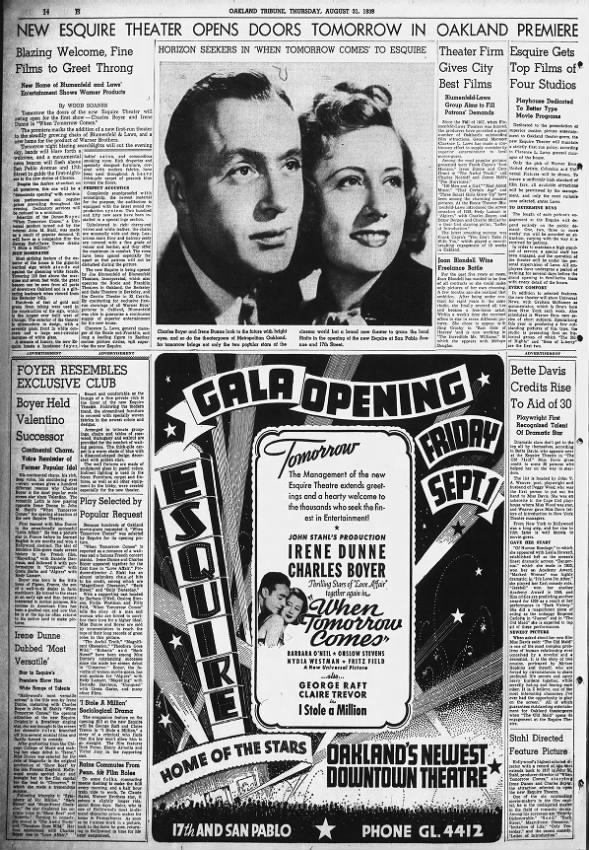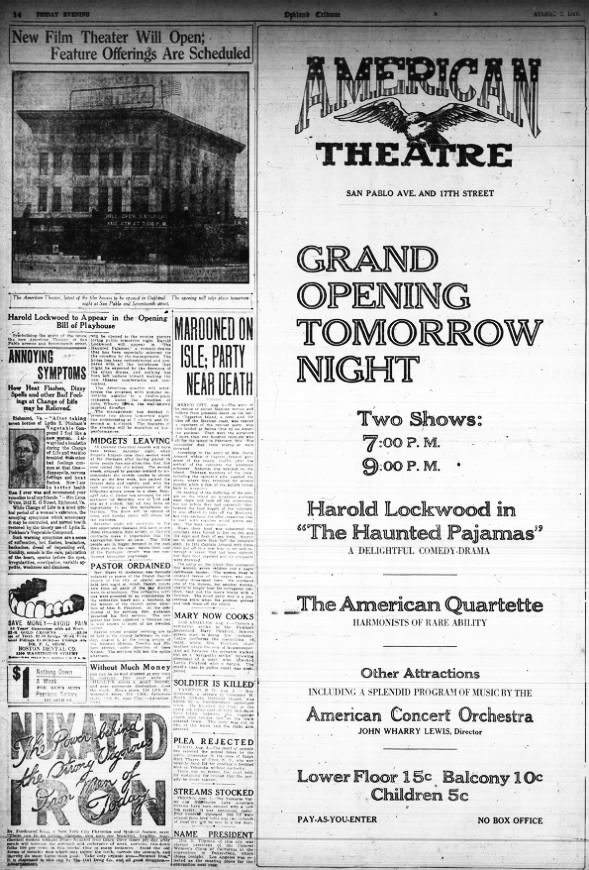
Esquire Theatre
1715 San Pablo Avenue,
Oakland,
CA
94612
1715 San Pablo Avenue,
Oakland,
CA
94612
![]() No one has favorited this theater yet
No one has favorited this theater yet
Showing 14 comments
Here is an item from The Film Daily of July 2, 1940:
Reopened as Esquire on September 1st, 1939. Ad below: Esquire theatre opening Thu, Aug 31, 1939 – Page 14 · Oakland Tribune (Oakland, California) · Newspapers.com
Esquire theatre opening Thu, Aug 31, 1939 – Page 14 · Oakland Tribune (Oakland, California) · Newspapers.com
Opened August 4th, 1917 American theatre opening Fri, Aug 3, 1917 – Page 14 · Oakland Tribune (Oakland, California) · Newspapers.com
American theatre opening Fri, Aug 3, 1917 – Page 14 · Oakland Tribune (Oakland, California) · Newspapers.com
Plans to remodel the American Theatre in Oakland were announced in the December 26, 1931, issue of Building and Engineering News:
Given gsmurph’s information that this house was located the Reliance Building, it’s clear that the Esquire was the Reliance Theatre that was mentioned in a list of current construction projects by the Van Sant-Houghton Company, published in the August, 1916, issue of The Architect and Engineer of California: “Reliance Theater and office building, Oakland (Seventeenth Street and San Pablo Avenue.)
The Reliance Theatre was mentioned in quite a few publications in 1916 and 1917, including the September 30, 1916, issue of The Moving Picture World, which said that the house had opened on September 2nd. An earlier issue of the same publication said of the theater, then under construction, that it was “…on the site of the old Rice Institute, but the old building has been practically rebuilt.”
The most effusive piece on the theater I’ve found is from the September issue of Pacific Service Magazine, the house organ of the Pacific Gas & Electric Company:
Despite the many mentions of the Reliance Theatre on the Internet, I’ve so far been unable to track down the name of its architect.Here is an August 1940 ad:
http://tinyurl.com/yb63yyu
Here is an April 1950 ad from the Oakland Tribune:
http://tinyurl.com/2qxcqs
Sic transit gloria mundi:
Oakland Tribune 11/13/53
Old Esquire Theater Razed; Drive-In Will Occupy Site
One of Oakland’s historic landmarks, known since 1939 as the
Esquire Theater and since early motion picture days as the American Theater was being razed today. Joseph Blumenfeld, president
of Blumenfeld Theaters, Inc., said the theater at Seventeenth Street
and San Pablo Avenue which was closed more than a year ago is being torn down to make way for construction of a $200,000 drive-in restaurant and cocktail lounge.
The new structure, Blumenfeld said, will include a restaurant
and drive-in area on the ground floor with a cocktail lounge and snack bar on the second floor. he said it will be leased to the operator of a Berkeley drive-in.
Earlier this year, a permit was granted for weekly “name-band"
dances in the building. However, after a storm of protests which
reached the City Council, James McCoy, a San Francisco dance
hall operator, withdrew his application for the permit.
The theater site was occupied in early days by Bice’s Academy,
an early day dance hall. It was also headquarters for the Reliance
Athletic Club and for a time of Acme Athletic Club.
The theater, after being known for many years as the American,
was renamed the Esquire in 1939. It was damaged by a fire the following year.
Here is an August 29, 1940 article describing the re-opening:
ESQUIRE THEATER OPENS TOMORROW
Film Stars To Attend Fete Here
Searchlights will sweep the sky in Oakland tomorrow night, just as
they will in London, Berlin and other great cities in Europe â€" but
the reason fnr the illumination will be quite different. Instead of ferreting out enemy members the searchlights will be merely functioning as signposts to the new Esquire Theater, which is throwing open its doors at 17th and San Pablo to greet the season with a page of American history called “When the Daltons Rode.”
It was just a year ago today that the Esquire, remodeled from
the old American, celebrated its rebirth as a Warner product theater
ndcr the joint management of Joseph Blumenfeld and Clarence Laws.
Since then Europe has been tossed into a war and the Esquire has had a disastrous fire.
The Esquire is part of the chain of Blumenfeld theaters which include
in the Eastbay the Roxie and Franklin in Oakland, and the Berkeley
and Oaks in Berkeley. Opening night festivities will be under direction of Laws who is general manager for the Oakland group. The pictures for the future will be drawn from the budgets of Warners, Columbia, Universal and United Artists.
The Esquire was originally built about 1892 as the Reliance Building, later Reliance Athletic Club; it was altered and became known as the American, was modernized in 1932 with new drapes and seats, and an Art Deco facade and reopened with a showing of “Forbidden,” staring Adolphe Menjou and Barbara Stanwyck. It became the Esquire August 31, 1939.
Closed by a (cigarette-caused) fire in the balcony June 28, 1940, the Esquire was repaired and reopened on August 30 that year with searchlights, Hollywood stars, and either (according to one historical document) “When the Daltons Rode” with Randolph Scott, or (according to an Oakland Tribune article) “When Tomorrow Comes” with Charles Boyer and Irene Dunne, both of whom were reportedly among the stars at the reopening (possibly both films were shown that evening).
The Esquire was operated by Blumenfield Theatres, apparently for its entire run as a theater.
Here’s a coincidence – there were theaters named Esquire and Telenews in Oakland, but on different streets. The same two theaters were adjacent in San Francisco, as per this photo from the SF Public Library website:
View link
Status should read “Closed/Demolished.”
The Esquire was originally the American, and built before the 1920s. As the Esquire in the late 1930s, it was given a vertical sign tower almost identical to the Esquire Theatre in Sacramento, which partially survives—sign intact—as an IMAX theatre. One Bay Area collector has a set of doors from the Oakland Esquire, which feature cobalt blue etched glass panels.
The Esquire was demolished about 1954, (though some accounts say it was radically renovated into the Mel’s Drive-In reastauant that replaced it, and which has been used in various capacities since).